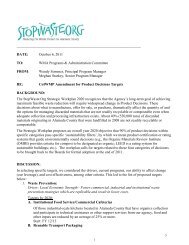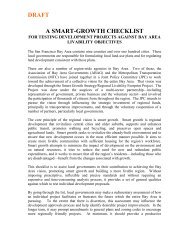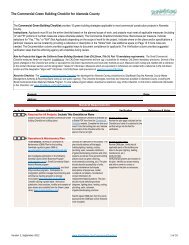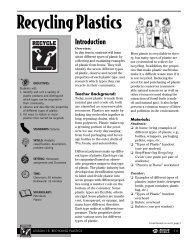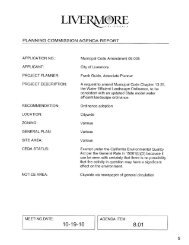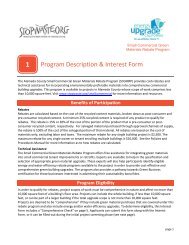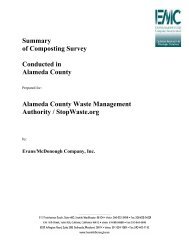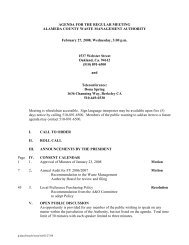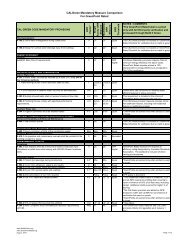Bay-Friendly Landscaping Principles and Practices - StopWaste.org
Bay-Friendly Landscaping Principles and Practices - StopWaste.org
Bay-Friendly Landscaping Principles and Practices - StopWaste.org
You also want an ePaper? Increase the reach of your titles
YUMPU automatically turns print PDFs into web optimized ePapers that Google loves.
<strong>Principles</strong><br />
& <strong>Practices</strong><br />
7. Reduce <strong>and</strong> recycle waste<br />
Description<br />
<strong>Bay</strong>-<strong>Friendly</strong> l<strong>and</strong>scapes offer many<br />
opportunities to reduce <strong>and</strong> recycle<br />
waste, both in the short term<br />
construction of the l<strong>and</strong>scape <strong>and</strong> in<br />
the long term, by designing spaces for<br />
collection <strong>and</strong> storing recyclable materials.<br />
Applications<br />
n Dedicate an easily accessible area to<br />
the collection & storage of materials<br />
for recycling.<br />
n List the types <strong>and</strong> estimated quantities<br />
of materials that will be generated at<br />
the job site.<br />
n Contact local recycling facilities<br />
<strong>and</strong> haulers to identify terms <strong>and</strong><br />
conditions required for recycling<br />
materials.<br />
n Develop <strong>and</strong> implement a plan to<br />
reduce construction waste including<br />
plastic plant containers, l<strong>and</strong><br />
clearing waste <strong>and</strong> other l<strong>and</strong>scape<br />
construction materials.<br />
n Specify the recycling or donating of<br />
unused materials to reach a goal of<br />
reducing waste by at least 50%.<br />
n Select suppliers that allow returns of<br />
unused items.<br />
n Select the nursery(s) that accept used<br />
containers.<br />
n Visit www.<strong>StopWaste</strong>.Org for<br />
additional information on materials<br />
reuse facilities <strong>and</strong> construction site<br />
cleanup contractors.<br />
n Offer incentives to contractors or<br />
employees who reduce waste.<br />
n Return wooden pallets to suppliers or<br />
take apart non-returnable wood pallets<br />
to chip for mulch.<br />
n Donate healthy plants to local<br />
nonprofits or school gardens.<br />
Benefits<br />
Tips for Success<br />
Recycling <strong>and</strong> donating unused items<br />
reduces pressure on l<strong>and</strong>fills, saves<br />
money by reducing tipping fees <strong>and</strong><br />
provides raw materials for future projects.<br />
Donations may be tax deductible.<br />
Using Salvaged Materials in the L<strong>and</strong>scape<br />
8. Separate plant debris for<br />
clean green discounts<br />
Description<br />
Most local l<strong>and</strong>fills <strong>and</strong> transfer stations<br />
offer a discount for disposing of plant<br />
debris if it is kept separate from other<br />
types of waste.<br />
Applications<br />
If reusing <strong>and</strong> recycling on site is not<br />
feasible, take the time to separate yard<br />
trimmings from other waste. At larger<br />
sites, dedicate a bin to plant trimmings<br />
only <strong>and</strong> ask the hauler for a reduction in<br />
the collection fee.<br />
Benefits<br />
Your disposal costs are trimmed, <strong>and</strong> in<br />
most cases, the material is processed into<br />
mulch or compost.<br />
1. Let the materials inspire the design.<br />
2. Locate materials early in the design process to avoid major design revisions<br />
when materials are found.<br />
3. Maintain flexibility in the design until materials are found.<br />
4. Use materials with interesting “stories” or cultural significance to the project.<br />
5. At the start of a project, evaluate project sites <strong>and</strong> old buildings for materials<br />
to reuse.<br />
6. Hire demo contractors with experience in deconstruction <strong>and</strong> salvage.<br />
7. Require contractors to provide a plan for construction <strong>and</strong> demolition<br />
salvage <strong>and</strong> recycling.<br />
8. Use materials for the highest use — avoid “down-cycling.”<br />
9. Include appearance <strong>and</strong> environmental performance st<strong>and</strong>ards in the<br />
specifications.<br />
10. Get the contractor on board with using salvage early in the process.<br />
Each year, the<br />
horticultural<br />
industry disposes<br />
of:<br />
n 130 million pounds of<br />
greenhouse film<br />
n 140 million pounds of plastic<br />
pots<br />
n 170 million pounds of plastic<br />
ground cover<br />
From: Texas A&M<br />
Source: Meg Calkins, Closing the Loop: Part II, L<strong>and</strong>scape Architecture, December 2002.<br />
26<br />
3






